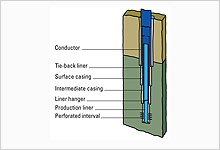1. n. [Drilling]
A casing string that does not extend to the top of the wellbore, but instead is anchored or suspended from inside the bottom of the previous casing string. There is no difference between the casing joints themselves. The advantage to the well designer of a liner is a substantial savings in steel, and therefore capital costs. To save casing, however, additional tools and risk are involved. The well designer must trade off the additional tools, complexities and risks against the potential capital savings when deciding whether to design for a liner or a casing string that goes all the way to the top of the well (a "long string"). The liner can be fitted with special components so that it can be connected to the surface at a later time if need be.
See related terms: casing joint, casing string, reciprocate, underream
2. n. [Well Completions]
Any string of casing in which the top does not extend to the surface but instead is suspended from inside the previous casing string. Many conventional well designs include a production liner set across the reservoir interval. This reduces the cost of completing the well and allows some flexibility in the design of the completion in the upper wellbore, such as when the fluid characteristics make it beneficial to increase the diameter of the conduit and components.
